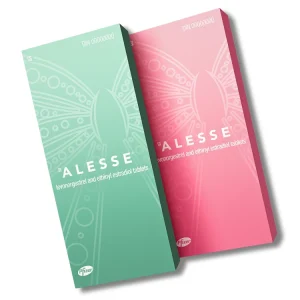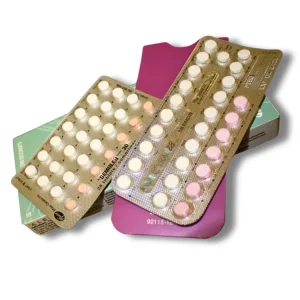Alesse Unveiled: A Hormonal Alliance for Pregnancy Governance
Alesse presents itself on the pharmaceutical landscape as a specific construct for oral intake, widely recognized within the family of combination birth control pills. Its fundamental purpose, its very reason for being, is to act as a bulwark against unintended pregnancy for women possessing reproductive capability. Alesse achieves its contraceptive aims by artfully deploying a synergistic pair of active hormonal agents: ethinyl estradiol, a laboratory-synthesized mimic of natural estrogen, and levonorgestrel, a man-made counterpart to the body’s own progesterone (classified as a progestin). These two hormonal entities engage in a meticulously coordinated interplay, designed to skillfully disrupt the usual progression of the female reproductive cycle through several distinct yet mutually reinforcing pathways of influence.
The Intricate Choreography of Hormones: How Alesse (Ethinyl Estradiol & Levonorgestrel) Obstructs Conception’s Path
The capacity of Alesse to effectively prevent pregnancy is deeply embedded in the carefully orchestrated actions of its estrogenic and progestogenic constituents. These hormonal signals weave a complex tapestry of physiological changes within the female reproductive system, collectively creating an internal environment that is fundamentally inhospitable to the initiation of a new life:
- Intercepting Ovum Maturation and Release (The Prime Directive – Halting Ovulation): To truly appreciate this core mechanism, one might envision the monthly ovarian cycle not merely as a biological process, but as a high-stakes countdown to a potential launch – the release of a mature egg (ovum) poised for fertilization. The hormonal messengers within Alesse (ethinyl estradiol and levonorgestrel) cleverly function as sophisticated counterfeit communiqués, dispatched to the brain’s supreme command centers for hormonal regulation (the hypothalamus and the pituitary gland). These deceptive signals effectively persuade the brain that the “launch window” for an egg has already passed, or that the prevailing hormonal climate is entirely unsuitable for such an event. In direct response to these misleading inputs, the pituitary gland significantly curtails its customary secretion of two pivotal “mission control” hormones: follicle-stimulating hormone (FSH) and luteinizing hormone (LH). FSH normally plays an indispensable role in nurturing the development and maturation of ovarian follicles (the intricate structures that house and prepare the eggs for their potential journey). The critical mid-cycle surge of LH, on the other hand, is the direct and absolute trigger for the “ignition sequence” of ovulation – the actual release of a ripened egg from the ovarian launchpad. By effectively dampening FSH production and, most crucially, by resolutely preventing this essential LH surge from occurring, Alesse fundamentally brings the entire “launch sequence” for egg release to a definitive standstill, well before the ovum can even commence its voyage. In the stark absence of an ovulated egg, no viable target exists for sperm to encounter and fertilize, thereby profoundly and effectively preventing the very possibility of conception and subsequent pregnancy from taking root.
- Transforming the Cervical Passage (Altering Cervical Mucus Properties): The progestin element (levonorgestrel) integral to Alesse also undertakes a significant role as a diligent gatekeeper at the cervix. It achieves this by inducing a notable transformation in the physical consistency and chemical characteristics of the cervical mucus. Under the usual conditions of a natural ovulatory cycle, particularly around the fertile window, cervical mucus typically becomes thin, watery, clear, and highly receptive, thereby creating an inviting and facilitative pathway for sperm to actively navigate their way from the vagina, through the cervical canal, and onward into the upper reaches of the reproductive tract where fertilization might normally occur. However, under the sustained influence of Alesse’s progestin, this cervical mucus tends to become markedly thicker, more viscous, stickier, and considerably less permeable to sperm. This altered, more tenacious mucus effectively functions as a formidable and challenging physical barricade, significantly impeding the ability of sperm to successfully penetrate the cervical os (opening) and gain access to the uterine cavity and fallopian tubes. This action substantially reduces the likelihood of sperm reaching any egg that might, against the odds, have been released.
- Reconditioning the Uterine Lining (Modifying Endometrial Receptivity): The synergistic hormonal partnership within Alesse also diligently and concurrently works to recondition and transform the endometrium—the specialized, dynamic, and highly vascularized lining of the uterus where a fertilized egg (blastocyst), should one miraculously be formed despite the preceding contraceptive mechanisms, would ordinarily need to securely implant itself and commence the complex processes of growth and development. Alesse generally encourages the endometrium to become thinner, less proliferative, less glandular, and generally less structurally and biochemically receptive or suitable for successful implantation. In essence, it makes the uterine “welcome mat” far less welcoming and ill-prepared to receive and nurture a potential early pregnancy. Consequently, even in the highly improbable and statistically unlikely scenario that ovulation were to somehow still occur and an egg were to be fertilized by a sperm despite the other powerful contraceptive safeguards in place, the significantly modified and less hospitable uterine lining would present a substantial and often insurmountable obstacle to the successful attachment and subsequent viability of any resulting fertilized ovum, thereby preventing the establishment of a clinical pregnancy.
These three distinct yet intricately interwoven mechanisms of action collaborate with impressive synergy to provide a very high and reliable degree of contraceptive security and peace of mind when Alesse is taken with unwavering consistency, meticulous accuracy, and precisely as directed by a qualified and informed healthcare professional.
Alesse’s Pharmaceutical Pedigree and the Modern Context of Generic Alternatives
Alesse first graced the medical world and was initially introduced to the market under the aegis and careful stewardship of Wyeth Pharmaceuticals (a notable pharmaceutical entity which, through the dynamic ebbs and flows of industry consolidation and evolution, was later assimilated into the larger Pfizer corporate structure). It rapidly established itself as a specific and widely embraced low-dose amalgamation of ethinyl estradiol and levonorgestrel, carving out a significant niche and becoming a frequently prescribed option among the diverse array of available oral contraceptive choices for women. Following the natural and legally mandated expiration of its foundational and exclusive patent protections, a broad and varied multitude of generic formulations of Alesse, all meticulously engineered to contain the identical active hormonal ingredients in the very same precise dosages and proportions as the original brand, have since become extensively and readily available to patients and prescribers alike. These generic versions are produced by a diverse range of reputable and licensed pharmaceutical manufacturing companies operating across the globe. Such generic equivalents are typically required by stringent national and international regulatory authorities (such as the FDA in the United States or the EMA in Europe) to undergo rigorous testing to demonstrate bioequivalence to the original innovator brand. This means they are expected, with a high degree of scientific certainty, to offer the same robust contraceptive efficacy, comparable pharmacokinetic profiles, and a similar overall safety and tolerability profile as the original Alesse, often while providing a more economically accessible and budget-friendly price point for consumers and healthcare systems.
Physical Form of Presentation and Common Packaging Arrangements for Users
- Tablets Intended for Oral Route of Administration: Alesse, along with its various generically equivalent counterparts that share its precise hormonal composition, is invariably and exclusively supplied to patients in the physical form of small tablets that are specifically designed and formulated for oral intake (swallowing). These contraceptive tablets are characteristically and conveniently packaged by manufacturers in user-oriented monthly dispenser units, often referred to as blister packs or compacts. The most frequently encountered and standard configuration for these dispenser units typically involves a carefully arranged set of 21 active, hormone-containing tablets. Each of these active tablets contains the precisely specified and quality-controlled amounts of both ethinyl estradiol and levonorgestrel. These 21 active tablets are often, though not universally, accompanied by an additional set of 7 inactive (placebo or reminder) tablets, thereby creating a continuous, unbroken 28-day cycle of daily pill-taking for the user. The active, hormone-laden tablets are, of course, solely responsible for delivering the contraceptive effect and preventing pregnancy. The placebo tablets, which are pharmacologically inert and contain no active hormonal ingredients whatsoever, are primarily included in the packaging regimen to assist the user in maintaining an unbroken and consistent daily pill-taking habit throughout the entire month. They also serve to clearly and conveniently demarcate the specific week during which withdrawal bleeding (a physiological bleed that is similar in nature and appearance to a normal menstrual period, though often lighter and shorter) typically and expectedly occurs as a result of the temporary cessation of hormonal intake.
Defining Characteristics and Unique Therapeutic Signature of Alesse (Ethinyl Estradiol 0.02 mg / Levonorgestrel 0.1 mg)
- A Synergistic Hormonal Contraceptive Formulation: Its most fundamental and defining identity lies in its precise nature as a combined oral contraceptive agent. This signifies that it strategically and effectively utilizes both an estrogenic hormonal component (specifically, ethinyl estradiol) and a progestogenic hormonal component (specifically, levonorgestrel) working in close concert and synergistic harmony to achieve its primary and overriding therapeutic objective of reliably preventing unintended or unwanted pregnancy in women.
- A Formulation Distinguished by a Modest Estrogen Content: Alesse is widely recognized, classified, and often specifically chosen within the medical and pharmaceutical communities due to its status as a “low-dose” oral contraceptive preparation. This particular designation is directly attributable to its specific and carefully measured ethinyl estradiol content, which is precisely 0.02 milligrams (often expressed as 20 micrograms or 20 mcg). This intentionally lower and more refined dose of the estrogen component is meticulously designed by pharmaceutical scientists to provide robust, consistent, and highly reliable contraceptive protection for the user, while simultaneously and importantly aiming to potentially minimize or significantly reduce the incidence, likelihood, or perceived severity of certain well-known estrogen-related side effects. Such side effects were sometimes more commonly associated with older generations of oral contraceptive pills that contained substantially higher doses of estrogen.
- Integration of a Well-Vetted and Time-Tested Progestin (Levonorgestrel): The progestin component that forms an integral part of Alesse’s dual-hormone composition, levonorgestrel, is a highly established, extensively researched, globally utilized, and time-tested synthetic progestin. It possesses a long, rich, and well-documented history of safe, effective, and reliable use within a multitude of different oral contraceptive formulations that have been available to women for many decades. Levonorgestrel is generally and widely known and respected within the medical field for its consistent and robust contraceptive efficacy when appropriately dosed, as well as for a broadly favorable and generally well-accepted tolerability profile among a diverse population of users worldwide.
- A Multi-Faceted and Robust Strategy for Ensuring Contraceptive Effectiveness: The notable and clinically proven effectiveness of Alesse as a reliable method of birth control is firmly and deeply rooted in its sophisticated, multi-layered, and scientifically validated approach to beneficially interfering with the normal, complex female reproductive process at several key junctures. Its primary, most crucial, and arguably most powerful action is the consistent and effective inhibition of ovulation (the monthly release of an egg from the ovary). However, this central mechanism is powerfully supplemented and reinforced by its concurrent ability to beneficially thicken the cervical mucus (thereby creating a more challenging barrier that significantly impedes sperm transit towards the uterus and fallopian tubes) and also to induce specific changes in the lining of the uterus (the endometrium) that render it substantially less receptive and hospitable to the potential implantation of a fertilized egg, should fertilization against all odds occur. This carefully orchestrated combination of distinct yet synergistically interacting physiological mechanisms contributes significantly and directly to its very high and consistently demonstrated degree of contraceptive reliability and user confidence, provided that the medication is used correctly, diligently, consistently, and precisely as prescribed by a qualified and informed healthcare professional.




Adding my two cents on Alesse! Was kinda nervous about starting a new BC, you always hear stories, right? But it’s actually been super smooth sailing for me. The first month my boobs were a little tender, not gonna lie, but that completely went away. And my skin? Actually looks better than it has in ages! So yeah, thumbs up over here.